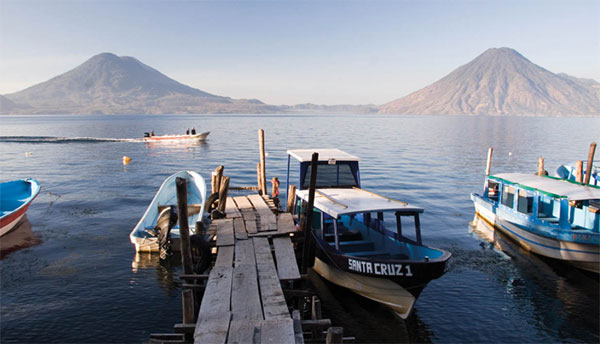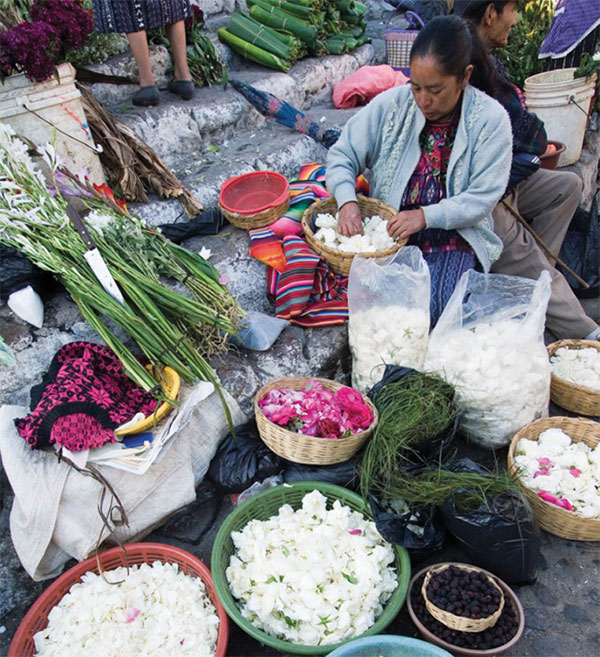THE CHURCHES OF ANTIGUA
Antigua’s numerous churches, characterized by a unique ‘squat Baroque’ style, are the dazzling jewels in this colonialized city’s crown. Built with immensely thick walls, and supported by colossal foundations and giant buttresses, the churches were developed in a futile effort to resist the perpetual tremors that have plagued the city since it was founded in 1543. Structurally, 21st-century Antigua is almost entirely an 18th-century city. A few earlier details have survived, but the dominant style is Iberian-American Baroque, a supremely pictorial, decorative, and flamboyant style that’s expressed on virtually all Antigua’s church facades. It’s also called Churrigueresque, and not to everyone’s taste. The Maudslays, who wrote A Glimpse at Guatemala, based on visits in the late 1890s, the height of the Victorian Gothic revival, considered it vulgar, garish, and ostentatious. But at its best, as witnessed at the restored La Merced, or at Santa Cruz, the depth, fluidity, and theatrical nature of
Antiguan Baroque is utterly astounding – undeniably grandiose, with dreamy facades embellished with astonishing detail. These remarkable facades were created by applying layers of plaster over the exterior masonry, a technique called ataurique, which can often be identified by floral or vegetal decorative details.
The sheer number of ecclesiastical buildings in Antigua is amazing: there are over 30 within a few blocks of the Parque Central. By the mid-17th century, all the main denominations and many more minor ones were established in the city. The religious orders were possibly the greatest power in Central America: free from taxation and granted huge swathes of the most productive land where sugar, tobacco, wheat, and, most lucratively, cochineal and indigo were farmed.
The orders were also allocated vast numbers of Maya laborers to work in the fields and construct the grand edifices of the capital. These laborers managed to implant Indigenous imagery onto some of the great church facades: corn cobs (sacred to the Maya) at La Merced and the white water lily (a hallucinogenic used in sacred rituals) at San Francisco.
Around Lago de Atitlán
The north shore of the lake is sparsely populated and the perfect place to head for some real relaxation. The first place the boat heading west to San Pedro stops at is Santa Cruz La Laguna, the main village high above the water, with a variety of lakeside hotels and outdoor activities, from kayaking to hiking. Santa Cruz is also a hub for lively nightlife, as well as a growing number of superb Spanish-language schools. Also, a new wave of eateries are resurrecting ancient Maya recipes with local, organic products. If you plan to climb Volcán San Pedro, this is the ideal base for an early-morning start.
San Marcos La Laguna 8 [map] takes the top prize for lakeside beauty. This has, predictably, pulled in the visitor crowds, particularly those on a spiritual path. The dense foliage gives way to an aromatic tangle of jocote, banana, mango, and avocado trees – the perfect setting for a meditation-yoga center and some excellent budget and mid-range hotels. In nearby San Juan La Laguna, you’ll find a weaving co-op run by the locals and an excellent village-based tourism initiative designed to promote the regional arts and crafts.
San Pedro La Laguna 9 [map] , a short distance beyond San Juan, now often matches Panajachel in popularity, drawing scores of visitors to its lakefront hotels that make an excellent base for hiking, kayaking, and scuba-diving.
Tip
If you are in Santiago Atitlán over Easter, you can watch the symbolic confrontation in the plaza between Jesus Christ and Maximón that always takes place on Good Friday.
A road runs around the east side of the lake, connecting Pana with another two interesting villages. Santa Catarina Palopó, 4km (2.5 miles) from Pana, is famous for its weavings. You will see the turquoise and purple huipiles at markets all over the highlands. There’s not much to see in the village itself, though as ever the volcano views are magnificent.
Santiago Atitlán ) [map] , a Tz’ utujil Maya village on one of the lake’s inlets around the western flank of Volcán Tolimán, is 20 minutes from Pana by fast lancha boats. A shrine is kept here to Maximón, part evil saint, part pagan idol, said to be a combination of San Simón, Judas Iscariot, and Pedro de Alvarado the conquistador. The two other points of interest are a small weaving museum to the left of the dock, and the church.

Boats at Santa Cruz La Laguna, Lago de Atitlán.
Corrie Wingate/Apa Publications
Quiché: the Maya heartland
The mountainous department of Quiché stretches from Chichicastenango northward as far as the Mexican border. As the name suggests, this is the heartland of the 2 million or so K’i che’ Maya, the most numerous Maya group in Guatemala. Quiché has had a long history of bloodshed, from the days of the Conquest when, in 1524, Alvarado’s men massacred Maya warriors after a final battle at K’umarkaaj, near Santa Cruz del Quiché, to the horrors of the ‘scorched earth’ policy of the 1980s, when thousands of Maya civilians were massacred in a series of paramilitary operations. The department is crossed by several mountain ranges and travel to the Ixil region in the north is a long slog, taking up to three hours from Santa Cruz del Quiché on steep roads.
Fact
Highland costumes are decorated with a wide range of flora and fauna motifs as well as geometric forms. Some images, such as the horse, peacock, and chicken, are obviously post-Conquest, as these animals arrived in the Americas with the Spaniards. Others, like deer, snakes, and double-headed birds figure in Maya mythology. It is said that the zigzag patterns symbolize Chac, the god of lightning. Monkeys are associated with disaster, while the quetzal was the spiritual protector of the rulers.
Chichicastenango
Chichicastenango ! [map] is a quiet highland town with an intriguing past that has become one of the chief tourist destinations of the highlands. Twice a week, the normally calm ‘Chichi’ hosts the most famous market in the Maya region, coming to life in a maelstrom of furious commerce. From the dead of night every Thursday and Sunday, traders arrive to set up their stands by candlelight, and by daylight the roads into town are crammed with trailers, trucks, and camionetas (buses). The market is a good place to buy típica textiles and handicrafts, short of venturing to their place of origin.

Wares for sale at the Thursday market, Chichicastenango.
Corrie Wingate/Apa Publications
Sitting pretty in the main plaza, the whitewashed Iglesia de Santo Tomás (daily) is an overwhelming sight, the air around the crescent-shaped stone steps thick with the sweet, smoky aroma of smoldering pine-based incense called copal. The church, dating back to 1540, is one of the most fascinating in Guatemala, a place where Maya religious traditions have long been tolerated and fused with Catholicism. Enter by the side door (the front door is reserved for priests and cofrades – religious officials). The atmosphere inside is magical on Sundays, the aisles and the altar packed with Maya families and groups softly praying. Candles, aguardiente liquor wrapped in corn husks, and flowers are offered at different platforms spread around the church, each dedicated to the souls of the deceased.